Lesson 3: Performing an Exchange Server 2003 Installation
The installation of Exchange Server 2003 is critical, yet many administrators take the installation process far too casually. One of the most important choices you make during the installation of Exchange is the creation of the organization name because once your organization is up and running, it is very difficult to change the configuration without causing severe disruption to your users. Therefore, it is important to carefully step through each part of the installation process.
After this lesson, you will be able to
-
Understand the types of installations you can perform
-
Successfully install Exchange Server 2003 into a new organization
Estimated lesson time: 45 minutes
Installation Types
There are two primary types of installations available when the Microsoft Exchange Installation Wizard starts. They are:
-
Create a New Exchange Organization This installation type is the topic of this chapter.
-
Join Or Upgrade An Existing Exchange Server 5.5 Organization This installation type, which also includes coexisting with and upgrading Exchange 2000 Server, is the topic of Chapters 4 and 5.
The following list identifies the available switches that can be used with the Microsoft Exchange Installation Wizard (Setup.exe), and their function:
-
/ChooseDC dcname Specifies a domain controller to be used during Setup for the reading and writing of Active Directory information. This switch is especially useful when you are installing multiple Exchange Server 2003 servers simultaneously in the same domain, such as in a lab or classroom environment. You can force each Setup instance to use the same domain controller, which results in the computer accounts for each Exchange Server 2003 server being created in the Exchange Domain Servers group on one server and then replicated out from there to other domain controllers. Without using this switch, you would have multiple domain controllers being used and replication clashes as a result, which could prevent some Exchange servers from being able to start their services properly after Setup completes.
-
/DisasterRecovery Recovers an Exchange installation after the server's configuration has been restored from backup. Using this switch causes Setup to skip reregistering the server with Active Directory and writing any data to Active Directory. Instead, Setup reinstalls the Exchange binaries, so you can then restore the information stores from backup and re-mount them.
See Also Chapter 12, "Backup and Restore," discusses recovering Exchange Server 2003 from disaster in much more detail.
-
/ForestPrep Prepares the Active Directory forest for the Exchange Server 2003 installation. You only need to run this once in a forest.
-
/DomainPrep Prepares each Active Directory domain that will have an Exchange Server 2003 installation, or mailbox-enabled objects such as user accounts. DomainPrep is run in each domain that fits the criteria.
-
/? Displays a list of all of the command-line switches with a brief explanation of their function.
-
/CreateUnattend filename.ini – Creates an .ini file where filename.ini is the name of the file that will contain all the information necessary to perform an unattended installation of Exchange Server 2003. In Lesson 4, you will create an unattended installation .ini file and use it to install Exchange Server 2003.
-
/EncryptedMode – Encrypts the .ini file to protect it from being read by unauthorized personnel.
-
/UnattendFile filename.ini – Performs an unattended installation using the .ini file specified. This switch can be further modified by other Setup switches related to unattended installation.
-
/Password password – Specifies the password of the currently logged on user as a Setup switch, which will auto-logon rather than prompting you during Setup.
-
/ShowUI – Displays the wizard user interface even though Setup is running in unattended mode; this switch is used in conjunction with the /UnattendFile switch.
Tip This is useful if you want to monitor the installation visually without having to intervene, or if your unattended installation is failing and you need to see where in the process the failure is occurring.
-
/NoEventLog Prevents Setup from writing any event information to the Windows event logs (System, Application, or Security). Routine messages generated by the Setup program won't create additional clutter in the event logs.
-
/NoErrorLogging – Disables any error logging during Setup.
-
/All – Enables all Exchange components for an install, upgrade, or reinstall.
Tip Use this switch if you need to force the installation or reinstallation of a component that the Setup utility wasn't making available.
Performing an Installation of Exchange Server 2003 into a New Organization
After running ForestPrep and DomainPrep, you are ready to begin installing Exchange Server 2003. The previous Setup switches provide a lot of flexibility in managing the behavior of the Setup program. However, the first type of installation you will perform is installing Exchange Server 2003 without any Setup switches into a new organization. When you do this, a new Exchange Server 2003 organization will be created in the forest. Because Active Directory supports only one Exchange Server organization per forest, you can create a new organization in a forest only if one does not already exist.
Practice: Installing Exchange Server 2003 into a New Organization
In this practice, you will complete the exercise of installing Exchange Server 2003 on the Windows Server 2003 server on which you previously ran ForestPrep and DomainPrep. While it is tempting to install every available component when performing an installation, at this time, you will perform a typical installation. Later you will add additional components, as necessary. Installing Exchange Server 2003 into a new organization is the simplest installation since there are no coexistence issues to manage.
Exercise 1: Run the Microsoft Exchange Installation Wizard to Install Exchange Server 2003
Before you begin, make sure you either have the Exchange Server 2003 installation CD in the CD-ROM drive or have reliable access to the source files for the installation. In the real world, you would likely be installing directly from a local CD-ROM.
To begin installing Exchange Server 2003, you need to have completed the pre-installation tasks that were discussed in Lessons 1 and 2 of this chapter. If you have not yet completed the tasks, do so before proceeding.
-
With the Exchange Server 2003 installation CD in the CD-ROM drive, go to the run line and execute <drive>:\setup\i386\setup.exe (where <drive> is your CD-ROM drive). Do not use any of the installation switches here.
The first page you will see is the Welcome page for the Microsoft Exchange Installation Wizard. This page describes the basic functions of the wizard and prompts you to click Next to continue with Setup.
-
You are prompted to read and agree to the End User License Agreement (EULA). This is a step that many administrators skip, but as the person installing the software, you should understand what you are agreeing to when you click I Agree. After you read through the EULA, click I Agree, and then click Next.
Important Licensing is one of the most misunderstood aspects of systems administration, and failing to read and understand the EULA is the primary cause. IT professionals who install and support the software must be able to accurately convey licensing details to both management and end users. IT professionals are often caught in the middle between users who believe they need every program the company owns installed on their computers and management that doesn't understand why it needs to buy copies for both the users' office computers and home computers when they can't physically use both systems at the same time. Failure to properly understand and abide by EULAs has resulted in many problems for companies, and when companies have problems, often their administrators are blamed.
So while it may seem tedious and a waste of time to read the EULA on a product you're going to install, by doing so, you are fulfilling your responsibility as an administrator.
-
On the Component Selection page, shown in Figure 2-5, you can choose the Exchange Server 2003 components that you want to install. You can also change the installation directory.
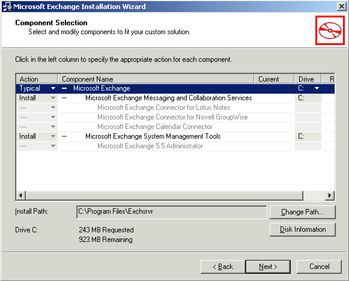
Figure 2-5: The Component Selection Page -
Click the Action column to the left of the Microsoft Exchange component. A drop-down menu presents the installation options, such as Typical, Custom, or Minimum.
When you select one of the options, the subcomponents are automatically updated to match your basic choice. For example, a Typical installation would install the Microsoft Exchange Messaging and Collaboration Services and the Microsoft Exchange System Tools subcomponents. If you choose a Custom installation, you manually choose the components you want to install. If you choose a Typical installation and then want to add a component, such as the Microsoft Exchange 5.5 Administrator, you'll have to change Typical to Custom in the Action column. Otherwise, any component you attempt to select that isn't part of a Typical installation will only give you the option for "none."
-
In the Action column, click Typical, and then click Next. You are prompted to choose the installation type, as shown in Figure 2-6. Here you indicate whether you are performing a new or an upgrade installation. Click Create A New Exchange Organization, and then click Next.
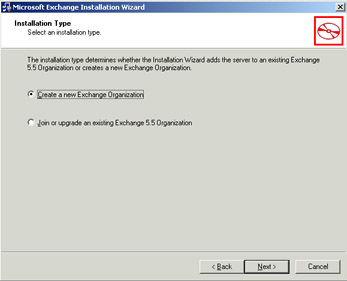
Figure 2-6: Creating a new organization or installing into an existing organization -
In the Organization Name box, type a name for your organization, and then click Next. As shown in Figure 2-7, First Organization is the default name.
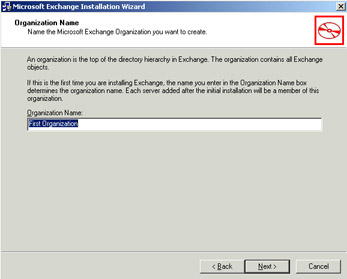
Figure 2-7: Defining the organization nameWhile you might use the default name in a test environment, create a more descriptive name in a production environment. However, do not use a name that is too restrictive or you might find the name doesn't apply later as your organization grows or changes. The company name is often a good choice for the organization name.
Note It is not impossible to change the organization name after Exchange has been installed, but it isn't a simple process. You must use the ADSIEdit utility to make the changes in Active Directory manually. This task is not recommended for the average systems administrator.
-
Confirm your installation choices on the Installation Summary page, shown in Figure 2-8. This is your chance to review the component choices you've made and to decide whether to move forward with the installation or to go back and make changes. After you confirm your installation choices, click Next.

Figure 2-8: Confirming your installation choices -
Review the Exchange Server licensing agreement shown in Figure 2-9. This agreement is different from the EULA and is specific to Exchange Server 2003 client access licensing requirements. Exchange Server 2003 supports Per Seat Licensing only. Click the option I Agree That I Have Read And Will Be Bound By The License Agreements For This Product, then click Next, and then click Next at the Installation Summary page to begin installing Exchange Server 2003.
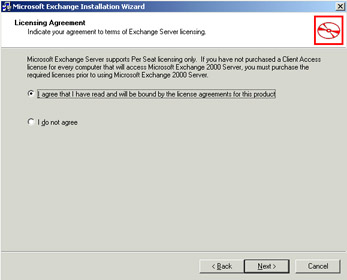
Figure 2-9: Exchange Server Per Seat licensing agreementSetup begins installing the components you selected. As shown in Figure 2-10, you can monitor the progress of the installation and see what task Setup is currently performing.
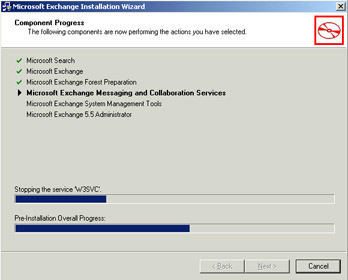
Figure 2-10: Tracking the progress of the installationBecause you performed the pre-installation tasks of running ForestPrep and DomainPrep, Setup will progress quickly to the Microsoft Exchange Messaging and Collaboration Services task after verifying the initial information in Active Directory. If you had not run ForestPrep in advance, Setup would do it for you in the Microsoft Exchange Forest Preparation stage, and it would take just as long as it did when you ran it separately—potentially an hour or more. After Setup finishes its tasks, the installation wizard will display a dialog box informing you that Exchange Server 2003 was successfully installed.
-
Click Finish, and your Exchange server is installed and ready to be configured for use. If a screen still appears prompting you to click Next when the installation is done, do so, and then click Finish.
Lesson Review
The following questions are intended to reinforce key information presented in this lesson. If you are unable to answer a question, review the lesson materials and then try the question again. You can find answers to the questions in the "Questions and Answers" section at the end of this chapter.
-
You are the administrator of an Exchange 2000 Server organization for the Active Directory domain contoso.com. You want to set up a separate test organization for Exchange Server 2003. You install a Windows Server 2003 server and join it to the domain and then attempt to install Exchange Server 2003 (since it is a test environment, you run ForestPrep and DomainPrep at the same time that you install the program). However, Setup only gives you the option to join an existing Exchange Server organization. Why?
-
In which of the following circumstances would you install Exchange Server 2003 into a new organization? (Choose two.)
-
Exchange Server 2003 must coexist with Exchange Server 5.5 or Exchange Server 2000.
-
You are preparing to migrate from Lotus Notes.
-
You are setting up e-mail for a new company that is just opening.
-
You already have an existing Exchange Server 2003 organization and need to install a second server to reduce the load on the first server.
-
-
Which of the following is not a valid Setup switch for Exchange Server 2003?
-
/disasterrecovery
-
/choosedc
-
/?
-
/forceremoval
-
/noerrorlog
-
/noeventlog
-
/all
-
Lesson Summary
-
The Microsoft Exchange Installation Wizard allows you to create a new organization or to join an existing Exchange Server 5.5 organization.
-
Exchange Server 2003 is licensed in Per Seat mode only.
-
Choose an organization name that is reflective of the organization but not so restrictive that a reorganization or other corporate change is likely to make it out of date.
-
Changing the organization name after installation can be accomplished manually with ADSIEdit, but it is not recommended.
-
Setup.exe can be modified with a number of switches to change the way it runs.
EAN: 2147483647
Pages: 221